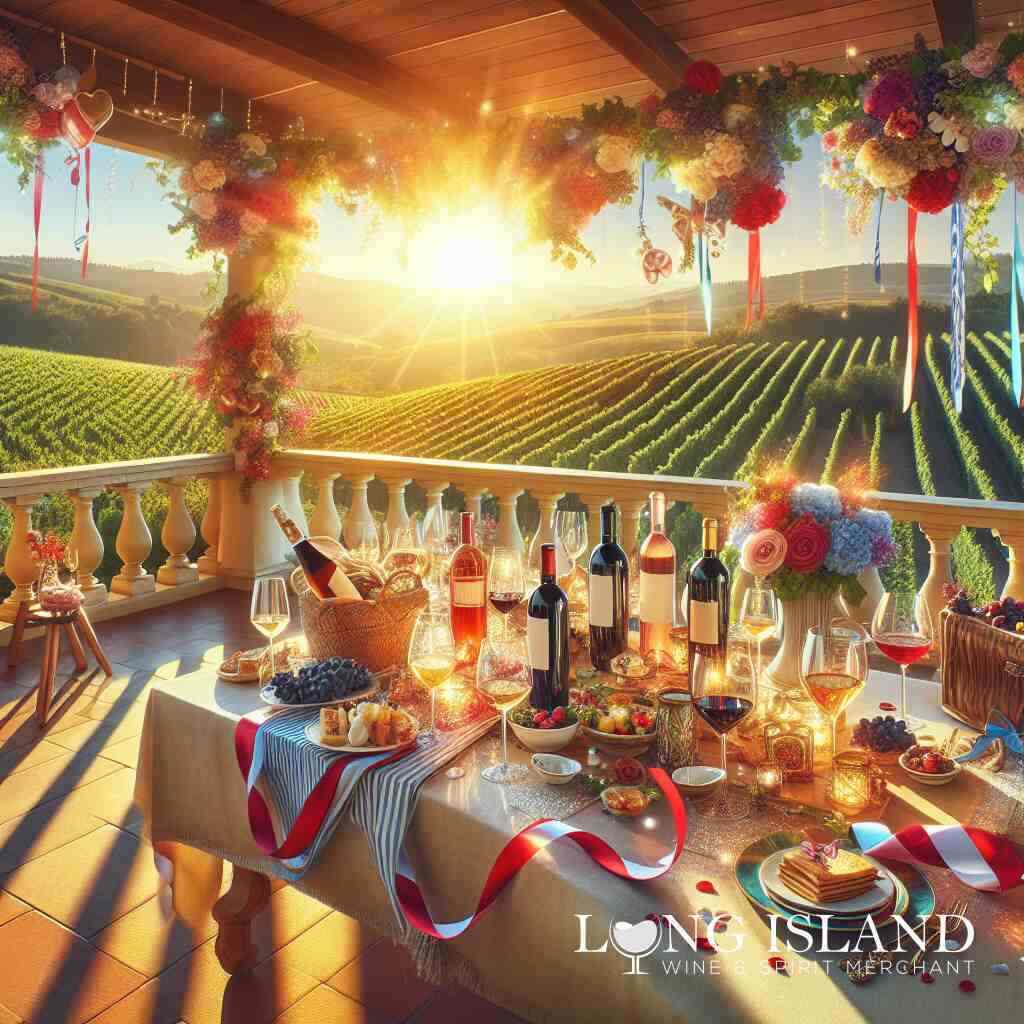
The Best Wine Selections for New Wine Enthusiasts
April 23, 2024
Embarking on Your Wine Journey
Understanding the Basics of Wine
Wine, one of the most cherished alcoholic beverages, has a history as rich and complex as its flavors. For the uninitiated, diving into the world of wine can seem daunting, but it all begins with understanding some fundamental concepts. Wine is the result of fermenting grape juice, a process that has been mastered over centuries. Each wine variety reflects the unique characteristics of its grape type, region of production, and winemaking techniques. Familiarizing yourself with the basic wine types-red, white, and rosé-is the first step toward becoming a wine enthusiast. Knowing how these wines are made, including the critical role of fermentation in winemaking, lays the groundwork for appreciating the nuances of each wine you taste.
First and foremost, it’s essential to recognize that wine speaks a language of its own, conveying stories of its origins and the people who produce it. Grasping the basics, from understanding the significance of the grape’s environment (terroir) to recognizing the implications of aging in oak, can enhance your overall experience and enjoyment of wine.
Why Starting with the Right Wine Matters
Beginning your wine journey with the right selection is crucial as it sets the tone for your entire wine-tasting adventure. Starting with wines that are too complex or outside your taste preferences might lead to a discouraging experience. Instead, beginners should look for wines characterized by their accessibility and widespread appeal. For instance, sweet red wines and smooth white wines offer a friendly introduction to the palate, avoiding the potential overwhelm of more robust or dry varieties.
Selecting the right wine encourages a positive and enriching learning experience, gradually building your palate to appreciate and enjoy a broader range of wine profiles. It’s like laying the foundation of a house, starting with the right components ensures a more stable and satisfying structure this case, a well-rounded wine appreciation and understanding.
Creating Your First Wine Experience
Creating your first wine experience is about more than just picking a bottle, it’s about setting the stage for an enjoyable and memorable moment. Choose a comfortable and quiet place where you can focus on the wine without distractions. It’s beneficial to have a few basic tools on hand, such as a proper wine glass, to enhance the tasting experience. The shape of a wine glass can significantly influence the aroma and taste of wine, funneling the wine’s bouquet to your nose and directing the wine to the optimal part of your mouth.
When you’re ready to taste, pour a small amount of wine into your glass where you can observe the color and clarity, which provides the first clues about the wine’s characteristics. Swirl the wine gently to aerate it, releasing its full range of aromas. Then, take a moment to inhale the bouquet before taking a small sip to savor the flavors. Reflect on the taste, body, and aftertaste, these elements will become more distinguishable as you gain more tasting experience.
Remember, the goal of your first wine experience isn’t to become an expert overnight but to develop a personal connection with wine. Curiosity and enjoyment are your best tools as you embark on this journey, discovering not only the vast world of wines but also your preferences and tastes.
Savoring the Sweetness
Sweet Red Wine for Beginners
Embarking on your wine journey can be made delightful and approachable by starting with sweet red wines for starters. These wines typically offer a gentle introduction to the complexities of red wines, combining the depth and character of red varietals with a welcoming sweetness that appeals to the new palate. Sweet reds like Lambrusco or a light-bodied Shiraz showcase fruity profiles and a comfortable entry point, allowing beginners to appreciate the nuances without the tannic intensity found in drier variants. At Long Island Wine & Spirit Merchant, you’ll find a curated selection that perfectly suits those early in their wine discovery journey, with options available for local delivery across New York and shipping to all 50 states.
Selecting a sweet red wine as your starting point eases the transition into more complex and varied wine profiles. It’s all about finding balance and enjoyment, enabling you to appreciate the craftsmanship behind each bottle. Plus, sweet red wines can be exceptionally versatile, pairing beautifully with a range of dishes from spicy cuisines to desserts, making them a fantastic choice for those exploring wine and food pairings for the first time.
Discovering Muscat and Moscato
Moscato wine, originating from the Muscat grape, is renowned for its sweet, fruity notes and delicate fizz, often making it a favorite among new wine enthusiasts. Diving into a Moscato intro for beginners, you’ll find that this varietal opens up a world of aromatic bouquets, offering scents of peach, nectarine, and orange blossom, complemented by a light and refreshing palate. This variety, whether still, sparkling, or rosé, serves as an excellent introduction, showcasing how wines can vary in sweetness, effervescence, and flavor profile.
Long Island Wine & Spirit Merchant features a diverse range of Moscato wines, inviting new enthusiasts to explore this captivating variety. Their selection, which includes options like pink Moscato and sparkling Moscato, caters to various taste preferences, ensuring that everyone can find a Moscato to love. Whether enjoyed as an aperitif, alongside dessert, or as a celebratory toast, Moscato offers a joyful exploration of wine’s sweeter side.
The Joy of Rosé and Late Harvest Wines
Rosé wines occupy a unique space in the wine world, offering a bridge between red and white wines with their varied shades of pink and flavor profiles. For those new to wine, exploring starter rosé wine can be an eye-opening experience, revealing the versatility and breadth of wine. Rosé can range from dry to sweet, light to medium-bodied, and still to sparkling, providing an extensive field for discovery and taste experimentation. Long Island Wine & Spirit Merchant’s selection of rosé wines is thoughtfully chosen to offer something for every palate, from the novice to the seasoned enthusiast.
Late-harvest wines, meanwhile, represent the sweeter spectrum of wine categories, made from grapes left on the vine until the end of the harvest. These wines concentrate the sugars, resulting in a richer, more luscious sip of wine that’s perfect for dessert or savoring on its own. For beginners, late-harvest wines and rosés reveal the potential for sweetness and complexity in wine, encouraging a deeper appreciation for the winemaking process and the various expressions of grapes depending on harvest and production techniques.
The Allure of Crisp Whites
Crisp White Wines for New Drinkers
Embarking on your wine journey with a glass of crisp white wine is like opening a window to a world filled with refreshing and invigorating flavors. For newcomers to the wine scene, crisp white wines for newbies offer an accessible and delightful introduction. These wines, characterized by their bright acidity and fresh, fruity, or floral aromas, are perfect for those looking to explore beyond the realm of sweet wines without diving into the deep end of full-bodied reds or oaky whites.
Among the myriad options, Sauvignon Blanc and Pinot Grigio stand out as prime choices for their universally appealing taste profiles. These varieties are known for their light to medium body, showcasing flavors ranging from green apple and lime to more exotic touches of passionfruit and jasmine. Such wines not only quench thirst but also inspire curiosity about the subtleties of wine flavors and the importance of terroir in winemaking.
Venturing into crisp whites opens up a lively category of wines that are versatile enough to enjoy on their own or paired with food. Whether you’re unwinding after a long day or looking for the perfect accompaniment to a light meal, starting with a chilled glass of crisp white wine sets the stage for a refreshing and enlightening experience.
Exploring Varieties: Sauvignon Blanc to Pinot Grigio
Diving deeper into the world of crisp white wines, beginners will find joy in exploring the range from the grassy and tropical notes of Sauvignon Blanc to the crisp, clean finish of Pinot Grigio. Each variety offers a unique entry point into white wine introductions, with distinct characters that reflect their origins and winemaking philosophies.
Sauvignon Blanc, for instance, may surprise you with its dynamic profile ranging from zesty lime to herbaceous bell pepper, a reflection of its diverse growing conditions from the Loire Valley to New Zealand. On the other hand, Pinot Grigio, predominantly from Italy but also cultivated in other regions, tends to present a lighter, almost serene drinking experience, often with hints of pear, lemon, and almond, embodying the essence of simplicity and elegance in a glass.
Engaging with these varieties not only broadens your palate but also enhances your understanding of how climate, soil, and craftsmanship converge to create the bottle in your hand. Discover our curated selection at Long Island Wine & Spirit Merchant. Through tasting and comparing, beginners gain invaluable insights into the vast and vibrant world of white wines, setting a solid foundation for further exploration and discovery.
Matching Food with Crisp Whites
One of the most exciting aspects of venturing into white wines is learning to pair them with food, transforming meals into harmonious culinary experiences. Crisp whites, with their refreshing acidity and bright flavors, excel in complementing a wide range of dishes. Understanding the basics of wine pairing can elevate a simple dinner to an occasion, making every sip and bite a moment to savor.
Sauvignon Blanc, for example, with its herbal and citric notes, pairs wonderfully with goat cheese, fresh salads, and seafood, enhancing the flavors of both the wine and the food. Pinot Grigio’s lightness makes it a versatile partner to lightly seasoned poultry and pasta dishes, as well as a refreshing counterbalance to creamy sauces, offering a palate-cleansing effect.
The art of pairing wine with food is accessible to everyone, from beginners to connoisseurs, and experimenting with different combinations can be as educational as it is enjoyable. Through trial and discovery, you’ll develop a sense of which wines complement your favorite dishes, adding a layer of personal enjoyment to your wine journey.

Diving into Red Wines
Smooth Red Wines for Beginners
When taking the first steps into the world of red wines, it’s essential to start with varieties that offer a smooth, approachable profile. Smooth red wines for novices like Merlot and lighter-bodied Pinot Noir can be the perfect introduction, providing a gentle entryway without the overwhelming tannins that some of the more robust reds possess. Long Island Wine & Spirit Merchant offers a carefully selected range of these beginner-friendly reds, ensuring an enjoyable tasting experience right from the start.
Choosing a smooth red wine as your first foray into this category allows you to appreciate the subtle complexities and flavors that red wines have to offer. These wines typically exhibit notes of ripe red fruits like cherries and raspberries, a soft mouthfeel, and a pleasant, lingering finish. For more information on how to choose the right glassware to enhance your wine experience, visit Long Island Wine & Spirit Merchant. As you start with these less tannic varieties, your palate can gradually adjust and begin to explore and appreciate wines with more structure and depth.
Introduction to Merlot and Pinot Noir
Merlot and Pinot Noir stand out as two of the most accessible and widely loved red wines, making them ideal candidates for beginner wine enthusiasts. Merlot, known for its soft, velvety texture and flavors of black cherry, plum, and herbs, serves as a versatile introduction to red wines. Pinot Noir, on the other hand, offers a lighter body with delicate flavors of strawberry, cherry, and spices, combined with a smooth finish. These varieties not only represent red wine for beginners but also showcase the diversity within red wines, paving the way for new enthusiasts to explore a broader range of styles and profiles.
Understanding the nuances of these two types of wine can enhance your appreciation for winemaking and the factors that influence a wine’s character, such as climate, soil, and aging processes. They also offer a glimpse into the regional differences, demonstrating how a Pinot Noir from Burgundy contrasts with one from California or New Zealand.
Pairing Red Wines with Food
Embarking on the journey of pairing red wines with food opens up a new dimension to wine enjoyment, enhancing both the wine and the meal. Smooth red wines like Merlot and Pinot Noir are incredibly food-friendly, offering diverse pairing possibilities that can accommodate a wide range of tastes and occasions. Merlot, with its plush texture and ripe fruit notes, pairs beautifully with dishes like roasted chicken, grilled vegetables, or pasta with red sauce, accentuating the richness of both the wine and the dish.
Pinot Noir, with its higher acidity and nuanced flavors, complements a variety of foods, from salmon to duck to mushroom-based dishes. The wine’s elegance and subtlety bring out the depths of flavors in the food, creating a harmonious balance that elevates the overall dining experience. Learning about wine pairing basics can guide beginners through this enjoyable process, encouraging experimentation and discovery with each meal and glass of wine.
Navigating the world of red wines as a beginner is an exciting journey. By starting with smooth, accessible wines and learning to appreciate their qualities and pairing potentials, new enthusiasts can gradually build their confidence and curiosity toward exploring more complex and varied wine landscapes.
Essentials of Wine Tasting
How to Taste Wine Like a Pro
Wine tasting is an art that marries sensory appreciation with knowledgeable discernment. To taste wine like a pro starts with a visual inspection: observe the wine’s color and viscosity, as these can give clues about its body and age. Next, swirl your wine gently to oxygenate it, enhancing its natural aromas. Smell the wine before tasting it, the bouquet can reveal a myriad of scents, from fruit to earth to spice. When tasting, let the wine linger on your palate to identify the primary, secondary, and tertiary flavors. It’s about more than just the taste-wine’s texture, acidity, tannins, and aftertaste all contribute to its complexity. As you practice, your palate will become more refined, making each tasting a richly rewarding experience.
Tasting wine is a skill acquired over time, facilitated by exposure to different wine-tasting fundamentals. It’s an educational journey that enhances not just your appreciation of wine, but your enjoyment of it.
Understanding Wine Flavors and Aromas
The essence of wine lies in its flavors and aromas, these are what distinguish one varietal from another and what wine enthusiasts seek to comprehend and enjoy. Wines can present a vast spectrum of flavors, from the bright and fruity to the deep and earthy. Learning to identify these notes is a vital part of wine education for newcomers. For instance, white wines might evoke citrus, pear, or floral notes, while red wines can offer berry, plum, pepper, or chocolate nuances.
Moreover, the aromas of wine can be influenced by many factors, including the grape variety, the soil where the grapes were grown, and the method of aging. Wine education for newcomers aims to equip enthusiasts with the knowledge to not only recognize these scents but to understand their origins. As you delve into wine tasting, you’ll start to notice how even the most subtle flavors and aromas come together to create the wine’s unique profile.
The Importance of a Wine Glass
The glass from which you drink can significantly impact your wine-tasting experience. The shape of a wine glass is designed to complement the wine’s type, enhancing its aromas, and directing the wine to the best area of your palate. A wine’s bouquet is more concentrated, allowing for a fuller aroma experience, while the design can also influence the wine’s aeration and temperature.
For example, red wines benefit from glasses with a wider bowl that increases the wine’s contact with air, allowing it to breathe and release more flavor nuances. White wines, on the other hand, are best served in glasses with a narrower bowl to preserve their crispness and aroma intensity. Investing in quality wine glasses is an essential step in setting up a starter wine collection guide, enhancing not just the flavor of the wine but the overall enjoyment of drinking it.
Exploring Wine Types and Varieties
Introduction to Wine Types
The journey into the world of wine can be both exhilarating and overwhelming due to the plethora of varieties available. From the bold and robust reds to the light and crisp whites, and not forgetting the delicate rosés, each type offers its own unique experience and story. For beginners, exploring wine types for beginners is the perfect starting point for understanding this diversity. It’s crucial to recognize how wine’s flavor profiles, body, and acidity can vary dramatically from one type to another. This variety is a testament to the incredible adaptability of the grape and the creativity and skill of winemakers worldwide. By starting with a broad overview of wine types, newcomers can better navigate their preferences and discover the styles that resonate most with their palates.
Discovering the World of White, Red, and Rose Wines
Diving deeper into the wine experience involves getting acquainted with the three primary wine categories: white, red, and rose. Each category brings its own unique flavor profiles and tasting experiences that can transport the drinker to different corners of the globe. White wines, known for their freshness and acidity, range from sweet to dry and can evoke flavors of fruits, flowers, and minerals. Reds are beloved for their depth and complexity, often presenting layers of fruit, spice, and woodiness, with tannin levels that can add texture and structure to the experience. Rose wines strike a harmonious balance between the lightness of whites and the richness of reds, with color and taste that can vary widely depending on the grapes used and the winemaking process.
An exploration into these categories not only broadens one’s tasting horizons but also builds a solid foundation for further wine education and appreciation. The variance within each type, influenced by grape varieties and regions, speaks to the richness of the wine world waiting to be discovered by eager enthusiasts.
Unraveling the Mysteries of Port and Marsala
While many new wine enthusiasts are familiar with standard types of wine, such as white, red, and rose, there is an entire realm of fortified and dessert wines that offer deep, complex flavors and a rich history. Port and Marsala are two prominent examples of this category, offering a different perspective on what wine can be. Port wine, with its robust flavors and rich sweetness, is often savored as a dessert wine or after-dinner drink. Originating from Portugal, it comes in several styles, including Tawny, Ruby, and Vintage, each offering a unique tasting experience. Marsala, from Sicily, Italy, is equally versatile and can range from sweet to dry, making it a perfect companion for cooking or as a standalone sipper.
Acknowledging the detailed and intricate world of Marsala wine selections guide, and understanding the craftsmanship behind port wine through a guide to Taylor Port Wine, can significantly enhance a beginner’s appreciation for wine. These wines represent the depth and breadth of winemaking traditions and the incredible range of flavors that wine can offer, encouraging exploration into the more nuanced and lesser-known corners of the wine world.
Curating Your Wine Selection
Embarking on a wine journey can be akin to starting a new chapter of culinary discovery, full of diverse flavors, histories, and experiences. For new enthusiasts, knowing how to select the right wines to begin this journey is essential. With guidance from Long Island Wine & Spirit Merchant, curating your initial wine selection becomes not just easier, but also a significant step towards cultivating a lifelong appreciation for wine.
Building Your Starter Wine Rack
When starting a wine collection, it’s crucial to have a balance of versatility and personal taste. A starter wine rack might include a range of types to suit different meals and moods, from refreshing whites and vibrant rosés to smooth reds. It’s about creating a selection that offers an introduction to the broad spectrum of wine without overwhelming a beginner’s palate. Long Island Wine & Spirit Merchant suggests incorporating wines that span the basic categories while also throwing in a few unique bottles to expand your palate. For instance, a balanced selection might include a crisp Sauvignon Blanc, a soft Merlot, and a playful Moscato, each serving as a gateway to its respective category.
Investing in a quality wine rack is also worth considering, as proper storage plays a crucial role in maintaining the wine’s quality. Positioning your rack in a cool, dark place away from direct sunlight or vibration helps preserve the integrity of the wine until you’re ready to enjoy it.
Choosing the Right Wine for Any Occasion
Wine has the incredible ability to complement any moment, whether it’s a celebration, a quiet dinner at home, or simply unwinding after a long day. The key to choosing the right wine lies in understanding the context of its consumption. For casual gatherings, a light and accessible rose or white wine can set a lively and welcoming tone. Romantic dinners might call for a rich red wine, offering depth and complexity that enhance both the meal and the moment.
When selecting wine for special occasions, look beyond the label, and consider the story behind the wine, such as its origin and the winemaker’s philosophy. This narrative can add an extra layer of enjoyment, transforming the act of sharing a bottle into a memorable experience. Long Island Wine & Spirit Merchant staff are knowledgeable and eager to help customers find the perfect match for any occasion, ensuring you leave with a bottle that meets your needs and expectations.
The Essential Wines to Try for a New Enthusiast
For those new to the wine world, starting with approachable, easy-drinking wines is advisable before venturing into more complex varieties. Long Island Wine & Spirit Merchant recommends a few essential wines for beginners tasting to build a foundation for palate development. A sweet red wine, such as a Lambrusco or a Zinfandel, can introduce the nuances of red wines without the bitterness of tannins. A crisp white, like Pinot Grigio or a Chardonnay, unveils the refreshing acidity and fruit-forward flavors found in many white wines. And no starter collection would be complete without sparkling wine, offering a celebratory sensation with each sip.
As your palate evolves, experimenting with different varieties, regions, and winemaking techniques becomes a natural progression. This exploration is not just about tasting the wide array of wines available but also about understanding the intricate factors that influence a wine’s character, from terroir to aging processes. Over time, this knowledge enriches the tasting experience, turning each glass of wine into a journey of discovery.

Storing and Serving Your Wines
The Basics of Wine Storage
Understanding the wine storage basics is crucial for any new wine enthusiast looking to maintain the integrity of their collection. Proper storage conditions ensure that your wines age gracefully and remain enjoyable for years to come. Ideally, wines should be stored in a cool, dark environment with stable temperatures-around 55-58 degrees Fahrenheit is best. Humidity levels also play a vital role, they should be kept at about 70% to prevent corks from drying out. When considering storage solutions, horizontal racking is recommended to keep the cork moist and the wine sealed. Long Island Wine & Spirit Merchant offers a selection of wine storage options that cater to these needs, ensuring your wines remain in optimal condition until you’re ready to enjoy them.
The significance of these conditions cannot be overstated, fluctuations in temperature and exposure to light can lead to premature aging or spoiling of the wine. Investing in a proper storage solution can make the difference between a wine that reaches its full potential and one that falls flat.
Decanting Wine: When and Why
Decanting wine may seem like a practice reserved for sommeliers and seasoned wine aficionados, but it’s a simple technique that any wine enthusiast can master. The primary reason to decant is to separate the wine from any sediment that might have formed during aging. Sediment can be common in older bottles of wine and can affect the clarity and taste of the wine. By carefully pouring the wine into a decanter, you leave the sediment in the bottle, resulting in a clearer and more pleasant drinking experience.
Another reason to decant is to aerate the wine, allowing it to breathe. This process is especially beneficial for younger, robust red wines, as exposure to air can soften tannins and open up flavors and aromas, enhancing the overall tasting experience. When decanting for aeration, even just a few minutes can make a significant difference. However, the duration can vary depending on the wine’s variety and age.
Serving Temperatures and Glassware
The temperature at which wine is served can significantly affect its taste and bouquet. Serving wine at the proper temperature enhances its unique characteristics, making the tasting experience more enjoyable. Generally, red wines should be served slightly below room temperature, around 60-68 degrees Fahrenheit, while white wines and rosés are best enjoyed chilled, between 49-55 degrees Fahrenheit. Sparkling wines and champagnes are typically served colder, around 45 degrees Fahrenheit, to preserve their crispness and bubbles.
Matching the wine to the correct glass type is another aspect that can enhance your wine-drinking experience. Different shapes and sizes of wine glasses are designed to amplify the characteristics of specific wine types. For example, red wines are best served in glasses with a larger bowl to allow the wine to come into contact with more air, enhancing its flavors and aromas. White wines, on the other hand, benefit from glasses with a narrower bowl, helping to maintain a cool temperature and concentrate the bouquet.
Providing the right conditions for storage and serving can dramatically improve your enjoyment of wine. Long Island Wine & Spirit Merchant offers a range of wine accessories, including storage solutions and glassware, to help you get the most out of every bottle. Whether you’re just starting your wine journey or looking to enhance your current collection, paying attention to these details can elevate your wine experience from ordinary to extraordinary.
From Novice to Connoisseur
Embarking on a wine journey opens up a vast landscape of flavors, traditions, and knowledge that can be both exhilarating and, at times, bewildering for the new enthusiast. As you move from exploring the basic types and tastes of wine to gaining a deeper understanding, you transition from a novice to a connoisseur. This part of the journey takes you beyond just tasting and into the realms of wine geography, the community of wine lovers, and the broader culture surrounding wine.
Learning About Wine Regions
The world of wine is intrinsically linked to the places where wine is made region offering its unique stamp on the wines produced. The climate, soil, terrain, and local traditions of wine-making regions- from the rolling hills of Tuscany to the rugged landscapes of Napa Valley- contribute significantly to the taste and quality of the wine. Understanding these nuances elevates your appreciation of wine, transforming each glass into an exploration of its origins.
Delving into the specifics, Bordeaux offers robust reds, while Burgundy is renowned for its sophisticated Pinot Noirs and Chardonnays. New World wine regions, like Australia’s Barossa Valley and South Africa’s Stellenbosch, bring bold innovations and exciting flavors to the global wine table. Engaging with alcoholic beverage education can provide a structured approach to understanding these diverse wine regions, enhancing both your knowledge and tasting experiences.
Joining a Wine Club: Pros and Cons
For many wine enthusiasts looking to deepen their engagement with wine, joining a wine club can be an attractive option. Wine clubs offer numerous benefits, including regular shipments of curated wines, exclusive access to rare and new releases, and educational materials that enrich the wine-drinking experience. Members often enjoy invitations to tasting events and winery tours, opening doors to a community of like-minded individuals.
However, there are considerations before joining a wine club. Commitments, both in terms of cost and the receiving of wines not chosen by you, might not suit everyone’s preferences or budget. It’s important to research and select a wine club that aligns with your taste preferences and interests, ensuring it offers flexibility and a high-quality selection that justifies the investment.
Next Steps in Your Wine Discovery Journey
As you evolve in your wine journey, your next steps may involve a deeper dive into the collecting of wines, perhaps starting to age your collection. Investing in proper wine storage or even dedicating a space at home for a wine cellar could be on the horizon. Learning about the complexities of wine investment and the market could also pique your interest.
Continuing education through wine courses or certifications, such as those offered by the Wine & Spirit Education Trust (WSET) or the Court of Master Sommeliers, could further refine your palate and understanding of wine. Traveling to wine regions, experiencing the local vintages, and meeting the winemakers can provide invaluable firsthand insights and experiences that deepen your appreciation and love for wine.
Your journey from a novice to a connoisseur is a personal adventure, rich with opportunities to explore, learn, and enjoy. Whether it’s through books, community, courses, or travel, the world of wine invites you into a lifetime of discovery and pleasure. Engaging, exploring, and experiencing the breadth of what wine has to offer ensures that this journey is as rewarding as it is delicious.
Frequently Asked Questions
Question: What makes Long Island Wine & Spirit Merchant a good choice for purchasing beginner rose wine and smooth red wines for beginners?
Answer: Long Island Wine & Spirit Merchant is the perfect destination for those new to the wine journey, especially when looking for beginner rose wine and smooth red wines. Our extensive selection is carefully curated to ensure ease of drinkability and enjoyment for novices. We focus on offering a range of easy-drinking wines that appeal to a beginner’s palate, ensuring each customer can find the right wine to start their exploration. With a knowledgeable staff ready to guide you through our fine wine and good spirits selection, our dedication to quality and education makes us a trusted partner in your discovery of new tastes. Plus, with the convenience of alcohol delivery near you, starting or expanding your wine collection has never been easier.
Question: Can you provide wine-tasting tips for newcomers who want to learn how to appreciate the ‘The Best Wine Selections for New Wine Enthusiasts’?
Answer: Absolutely! For those looking to delve into ‘The Best Wine Selections for New Wine Enthusiasts’, Long Island Wine & Spirit Merchant offers invaluable wine-tasting tips to enhance your experience. First, start with a variety of easy-drinking wines such as a smooth red or a beginner rose to introduce your palate to different wine profiles gradually. Take the time to smell the wine before tasting it to identify the different aromas, as this can majorly influence your perception of taste. Utilize the right wine glass for each type of wine to optimize the flavor and aroma experience. Don’t rush, sip slowly to fully appreciate the complexity of each wine. Finally, keep notes on your thoughts and preferences, as this will help you track your progress and refine your tastes. Our knowledgeable staff is always here to recommend the best wines for tasting and guide you through the learning process, ensuring a rewarding journey for every new enthusiast.
Question: For clients starting a wine collection, how does Long Island Wine & Spirit Merchant suggest incorporating sweet red wine for beginners and crisp white wines for beginners?
Answer: Starting a wine collection with Long Island Wine & Spirit Merchant is an exciting journey into the world of wine. We suggest beginning with a variety of types to explore a broad spectrum of flavors. Including sweet red wine for beginners and crisp white wines can offer a well-rounded introduction to the different wine profiles. We recommend wines that are approachable and widely appealing, like a gentle Lambrusco or a refreshing Sauvignon Blanc, to start your collection. These selections not only provide an understanding of basic wine flavors but also ensure you have options for different occasions or meals. Explore our variety at Long Island Wine & Spirit Merchant. Our expert staff can help you select the perfect wines to create a balanced starter rack, considering your personal preferences and the versatility of each wine, ensuring a delightful exploration of fine wines suitable for any setting.
Question: What services does Long Island Wine & Spirit Merchant offer to help new wine enthusiasts explore wine varieties and find the best wines for tasting?
Answer: Long Island Wine & Spirit Merchant is dedicated to helping new wine enthusiasts explore the vast world of wine through a variety of services. We offer personalized recommendations to help you find the best wines for tasting, catering to your individual preferences and introducing you to wine varieties that match your taste profile. Our selection includes everything from sweet red wine for beginners to fine wines and good spirits, ensuring every enthusiast finds something they love. Additionally, we provide educational resources and tasting notes to enhance your understanding and enjoyment of each wine. With our alcohol delivery service, exploring wine varieties has never been more convenient. Whether you’re in Long Island or across the US, our goal is to make your wine discovery journey as enriching and enjoyable as possible. Learn more about the essentials of wine storage by visiting Long Island Wine & Spirit Merchant.
Question: How does Long Island Wine & Spirit Merchant guide beginners in choosing the right wine for any occasion?
Answer: At Long Island Wine & Spirit Merchant, we understand the nuances of selecting the right wine for any occasion can be daunting for beginners. Our experienced team is committed to guiding each client through the process, making it both simple and enjoyable. We consider factors such as the type of event, the menu, and your taste preferences. Whether seeking light and vibrant rose wine for a summer gathering or a smooth red wine for a cozy dinner, we offer expert advice and recommendations to ensure you choose the best wine for the occasion. Our extensive selection, from sweet red wine for beginners to exclusive fine wines, allows us to provide options that will enhance any event, ensuring a memorable wine experience every time.



